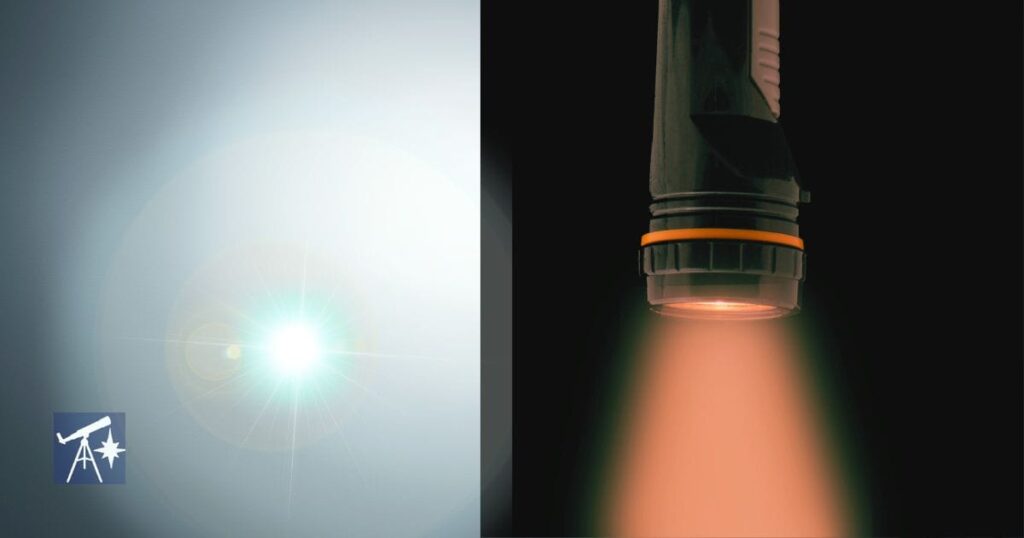A regular light can ruin your views of the night sky. A red light flashlight, designed for stargazing is what you need…

Did you know that white light switches off the rhodopsin for night vision? Night vision means your eyes are adapted to the dark and this is ideal for best views of celestial objects through your telescope or binoculars, or with naked eyes.
Key takeaway on why you need a red flashlight for astronomy
-> You need it to maintain your dark adapted eyes
-> You’re more likely to observe faint night-sky objects. You’ll get better views.
The more dark-adapted your eyes the better your stargazing experience. Your eyes can take hours to get fully adapted to the dark and reach optimal low light sensitivity, according to physicist, Dr Christopher Baird. The general advice for backyard astronomers is to give yourself at least 20 minutes for night vision, but the longer the better. It makes sense then that you don’t want to interrupt dark adapted eyes by using a regular light to read instructions or maps or to change eyepieces, etc.
The problem with regular flashlights or Torches
Regular flashlights emit white light, which disrupts the advance of night vision. It emits too much in the blue and green spectrum. With the brightness, your pupil shrink and this reduces the amount of light entering your eyes.
The Solution: Red light flashlights (AKA red light Torches)
At night we see more clearly once our eyes are adapted (takes about 20 min) and red light helps with maintaining that night vision than that emitted by the normal bright flashlights.
Why use red light for astronomy?
Red light does not disrupt the forming of rhodopsin, a chemical released by the body when our eyes detect low light for roughly 20 minutes. This chemical aids our night vision and evolved to help us detect threats at night.
Submariners and other professionals having to go from well-lit premises to the outdoors are familiar with how red light preserves night vision.
Imagine yourself observing the sky at night and wanting to read a sky chart, check your device, or look up instructions — you’ll need lighting to see these.
Especially, if you are just starting to learn the ropes of how to use your new telescope. Or if you have those extra eyepieces you’re yet to use. Red light is what you need.
As Jim O’Connor of the Tucson Amateur Astronomy Association explains: “It only takes a few seconds of bright light to cause the rhodopsin to decay…” and this is why astronomers use red flashlights when setting up, re-configuring, or referring to planispheres.
Red light torch app
You can use a red flashlight app if you don’t have a red flashlight. This is one way to improvise. For Apple, check out NightVision Light at the App Store, and for Android, Red Telescope Flashlight at Google Play.
DIY red light flashlight for astronomy
Instead of a red light flashlight you can cover a regular one with red cellophane or similar filter to reduce its white brightness.
How do you make a red light torch to use with your telescope?
Here’s how to make a red flashlight for astronomy: you simply adapt a conventional flashlight, as follows:
- Get some red cellophane and cover the front of the torch or flashlight with layers of the cellophane and then secure these layers with a rubber band for a DIY red flashlight. Trim the excess red cellophane and there you have it.
It’s as easy as that.

You can get red cellophane online
at Amazon (affiliate link
- Or for a red flashlight for night vision you can fit red gel light filter pieces over the lens. Art supply stores stock these, but they are also available at Amazon (click on the image below to see details and price).
Best red flashlight for astronomy
If you’re after a flashlight with a red lens, here are recommendations to buy.
Rechargeable red light torch
A rechargeable flashlight is handy. This one has a USB so you can charge it in your vehicle or using a solar charger or battery bank. It’s also waterproof.

Rechargeable red flashlight for stargazing
available at Amazon (affiliate link)
Lightweight small red light torch
Best red lens flashlight that fits in your pocket: For a flashlight, you can stick in your pocket or clip on your belt or carry bag, you can’t go past this small red flashlight that’s a lightweight LED…

Zoomable flashlight red LED
Available at Amazon (affiliate link)
If you want to free your hands, you can use a red headlamp. The problem with these is that they can get annoying when you are trying to look through the eyepiece of the telescope.
Where to buy a red light torch
You can buy red light torches or flashlights online at Amazon and astronomy specialty shops or techno gear shops.
Look for flashlights that shine a very pure red light.
Every backyard astronomer should have a red flashlight in their kit. They are essential for navigating in those best dark places, reading a planisphere, and adjusting settings on the telescope.
The best ones are astronomy-grade red flashlights. But, if you are just starting, you could get away with an app on your phone or by making your own — For how to make a red flashlight for astronomy – scroll up.

